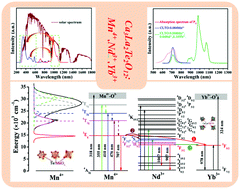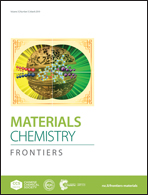Ca3La2Te2O12:Mn4+,Nd3+,Yb3+: an efficient thermally-stable UV/visible–far red/NIR broadband spectral converter for c-Si solar cells and plant-growth LEDs†
Abstract
A series of novel Mn4+,Nd3+,Yb3+-doped Ca3La2Te2O12 (CLTO) phosphors were prepared by substituting Te6+ for W6+ in the Ca3La2W2O12 compound using a high-temperature solid-state reaction method. A Mn4+ singly-doped CLTO phosphor (CLTO:0.004Mn4+) showed a bright deep red-light emission corresponding to a narrow band around 707 nm (14 144 cm−1) due to a Mn4+ 2Eg → 4A2g spin-forbidden transition upon 365 nm UV excitation, which largely overlapped the absorption spectrum of plant phytochrome Pfr. The excitation spectrum (λem = 707 nm) presented a broad band ranging from 250 nm (40 000 cm−1) to 600 nm (16 667 cm−1), which can be decomposed into four Gaussian bands peaking at 318 nm (31 431 cm−1), 355 nm (28 148 cm−1), 410 nm (24 385 cm−1), and 476 nm (20 992 cm−1), corresponding to a Mn4+–O2− charge transfer (CT) transition, and Mn4+ transitions 4T1g ← 4A2g, 2T2g ← 4A2g and 4T2g ← 4A2g, respectively. Moreover, three kinds of Mn4+ emission sites were analyzed with the assistance of time-resolved spectra. With the single incorporation of Nd3+/Yb3+ into CLTO:Mn4+, energy transfer phenomena from Mn4+ to Nd3+/Yb3+ ions can be observed, which proceeded via non-radiative resonant and phonon-assisted mechanisms, respectively, resulting in the broadband spectral conversion of the UV/blue to NIR light. When Nd3+ and Yb3+ were co-doped into CLTO:Mn4+ to form the tri-doped CLTO phosphors, a successive energy transfer process, Mn4+ → Nd3+ → Yb3+, was determined based on the simultaneous energy transfer processes Mn4+ → Nd3+ and Nd3+ → Yb3+ in the co-doped samples, further enhancing the broadband spectral conversion process of the UV/blue to NIR region, which can be absorbed by photosynthetic bacteria and show high response when applied to c-Si solar cells. More attractively, the luminescence thermal stabilities of both CLTO:0.004Mn4+ and CLTO:0.004Mn4+,0.04Nd3+,0.20Yb3+ showed excellent performance, and the temperature-dependent luminescence properties of the Mn4+,Nd3+,Yb3+ tri-doped materials have been investigated for the first time. These results indicate that this kind of phosphor can be potentially applied to improving spectral conversion efficiency for c-Si solar cells and plant-growth far-red/NIR LEDs. In addition, this report provides a strategy wherein hosts for Mn4+ doping can be well enriched by substituting Te6+ for W6+ in certain tungstate compounds, which is highly desired in searching for novel red-emitting phosphors.



 Please wait while we load your content...
Please wait while we load your content...